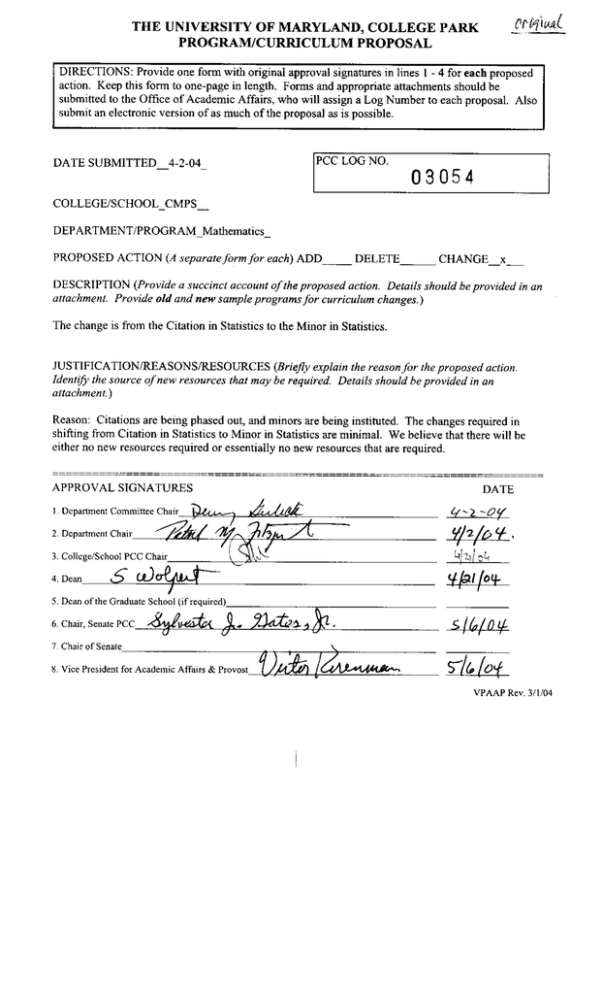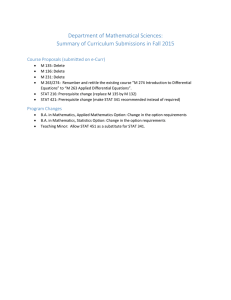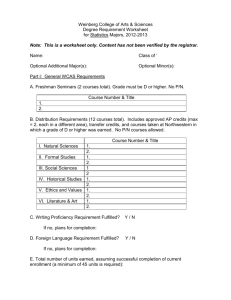Document 14300458
advertisement

MINOR IN STATISTICS The Department of Mathematics offers a Minor in Statistics for students whose majors are not mathematics. The goal of the Minor in Statistics is to provide the student with a substantial number of courses that are statistical in nature and involve a substantial amount of mathematics. TRANSCRIPT TITLE: Minor in Statistics CATALOGUE DESCRIPTION: The Minor in Statistics is designed for students whose majors are not mathematics, but who wish to have in-depth study of statistics from a mathematical perspective. The requirements entail 16 credits, from I - IV: I. Math 241: Calculus III (4 credits) II. One of the three pairs of 3-credit courses: Stat 400: Applied Probability & Statistics I and Stat 401: Applied Probability & Statistics II Stat 410: Introduction to Probability Theory and Stat 420: Introduction to Statistics Stat 410: Introduction to Probability Theory and Stat 401: Applied Probability & Statistics II III. Stat 430: Introduction to Statistical Computing Methods and SAS (3 credits) IV. One of the courses in (a) - (e): (a) Stat 405: Stochastic Models for Queues and Networks (3 credits) (b) Stat 440: Sampling Theory (3 credits) (c) Stat 470: Actuarial Mathematics (3 credits) (d) A third course in (II) not already taken to satisfy (II). (e) Econ 422: Quantitative Methods in Econometrics I(3 credits) Minor faculty coordinator: Professor Paul Smith, Dept. of Mathematics (pjs@math.umd.edu) DISCUSSION PERTAINING TO THE COURSES: The Minor coursework begins with Math 241 (4 credits), which is the third of the 3-course sequences of calculus courses designed for physical science, engineering and mathematics students and which form the foundation for a mathematics major. The student will be required to complete four upper-level courses that focus on statistics. First is the pair of courses in (1) below, or the pair in (2) below, or the pair in (3) below: (1) Stat 400 and 401, which together introduce students to the basic topics in probability and statistics, such as random variables, standard distributions, the law of large numbers, unbiased and consistent estimators, interval estimation, analysis of variance, and maximum likelihood estimators, hypothesis testing, regression, and non-parametric methods. (2) Stat 410 and 420: Stat 410 provides an introduction to probability theory, including random variables, distribution functions, moments, limit theorems. Stat 420 presents theoretical concepts of statistics, such as sufficiency, completeness, the information inequality and optimal testing, and sets forth key methods of inference, such as the use of likelihood, least squares, and nonparametric methods. (3) Stat 410 and 401: Stat 410 provides an introduction to probability theory, including random variables, distribution functions, moments, limit theorems. Stat 401 includes unbiased and consistent estimators, interval estimation, analysis of variance, and maximum likelihood estimators, hypothesis testing, regression, and non-parametric methods. Next, the student will be required to complete Stat 430: Stat 430 focuses on statistical analysis using SAS software to give numerical and graphical data summaries. The course includes applications to engineering, life science, business and social science. Finally, the student will be required to complete one of the following upper-level courses: A third course that is either one of Stat 400, 401, 410, 420, that is not taken to satisfy (II), or one of the following: Stat 405: Stat 405 dwells on generating functions, Poisson and renewal processes, queues, and Markov models. There are applications to computer and communications networks. Stat 440: Stat 440 focuses on sampling theory, estimation of sample size, various kinds of sampling with varying probabilities. Stat 470: Stat 470 is an introduction to calculations of life-insurance premiums, including compound interest, probability distribution and expected values derived from life tables, regular probabilistic behavior of large populations, and expected values arising in insurance problems. Econ 422: Econ 422 emphasizes he interaction between economic problems and the assumptions employed in statistical theory. The topics include formulation, estimation, and testing of economic models, including single variable and multiple variable regression techniques, issues relating to inference. Its prerequisites are Econ 200, 201, and 321. PRESENT CITATION IN STATISTICS: Math 241: Calculus III (4 credits) One 3-credit course in each pair: Stat 400: Applied Probability & Statistics I or Stat 410: Introduction to Probability Theory Stat 401: Applied Probability & Statistics II or Stat 420: Introduction to Statistics Stat 430: Introduction to Statistical Computing Methods and SAS (3 credits) One of the following courses: Stat 440: Sampling Theory (3 credits) Econ 422: Quantitative Methods in Econometrics I (3 credits) Biom 401: Biostatistics (3 credits) RELATION OF THE MINOR TO THE EXISTING CITATION IN STATISTICS: There are three alterations: 1. In (II) we have spelled out clearly which pairs of Stat 400, 401, 410, 420 are included in the requirement. (Note that Stat 400, 420 is not allowed, which is caused by the fact that Stat 410 is prerequisite to Stat 420.) 2. Since the coursework for the Minor in Statistics is focused on statistics, (IV) includes each 400-level statistics course other than those taken to satisfy (II), and other than Stat 464 and Stat 430 (already a requirement in (III). This gives a longer list of qualified courses to choose from at the 400-level. 3. Since Biom 401 is no longer offered and its successor, Biom 402, has had enrollment problems, we are deleting the Biometry course in the change from Citation to Minor. GRADES: The student will need to achieve at least a C- in each course for the Minor of Mathematical Statistics. OTHER ISSUES RELATED TO COURSEWORK: (a) The Minor in Statistics is NOT open to Math Majors. (b) A student may use a maximum of 2 courses to satisfy the requirements of both a major and a minor. (c) No more than 1 of the courses for the Minor may be taken at an institution other than the University of Maryland, College Park. OVERSIGHT: Professor Paul Smith, of the Department of Mathematics, has been the departmental coordinator for the citation and will continue for the Minor in Statistics. The Office of Undergraduate Studies keeps records and all information pertinent to the Minor as well as the students working toward the Minor. The Department of Mathematics expects to have a review of the Minor within a 5-year period. EXCEPTIONS: First, concerning the number of courses (credits) taken off-campus, there is the quality control issue (not all multivariable calculus courses are quite equivalent, and other courses suffer from the same issue). Also, CMPS has a policy that classes designated for the mathematics major cannot be taken off-campus. The same should be true for minors, since some students expecting to get a minor may choose later to switch to a major. Second, because there are 3 and 4 credit courses in the requirement, it is clearer to specify the number of courses (2) that can be taken at a different institution, rather than the number of credits. RESOURCE IMPLICATIONS: There are none known at this time.


